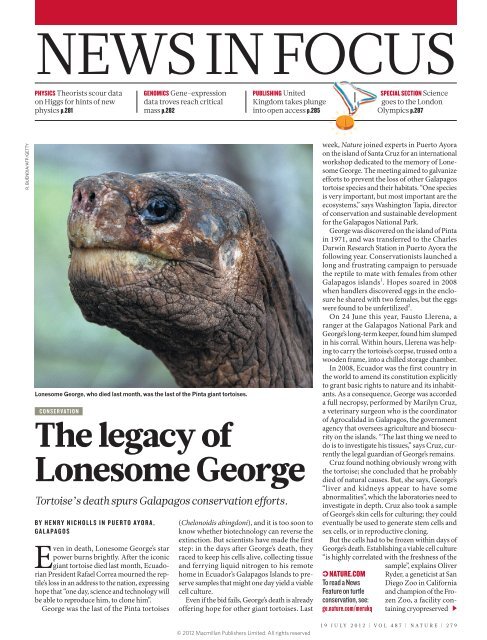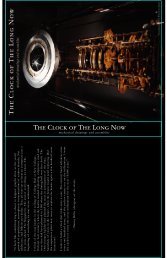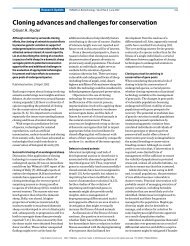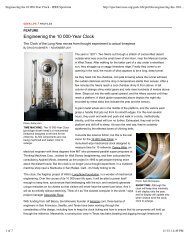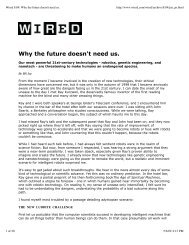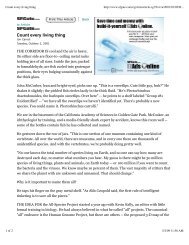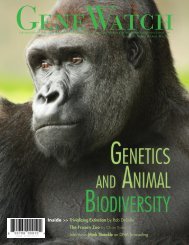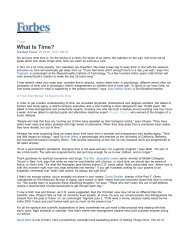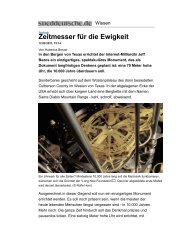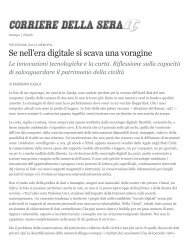The legacy of Lonesome George - Long Now > Media > Uploader
The legacy of Lonesome George - Long Now > Media > Uploader
The legacy of Lonesome George - Long Now > Media > Uploader
You also want an ePaper? Increase the reach of your titles
YUMPU automatically turns print PDFs into web optimized ePapers that Google loves.
R. BUENDIA/AFP/GETTY<br />
NEWS IN FOCUS<br />
PHYSICS <strong>The</strong>orists scour data<br />
on Higgs for hints <strong>of</strong> new<br />
physics p.281<br />
BY HENRY NICHOLLS IN PUERTO AYORA,<br />
GALAPAGOS<br />
Even in death, <strong>Lonesome</strong> <strong>George</strong>’s star<br />
power burns brightly. After the iconic<br />
giant tortoise died last month, Ecuadorian<br />
President Rafael Correa mourned the reptile’s<br />
loss in an address to the nation, expressing<br />
hope that “one day, science and technology will<br />
be able to reproduce him, to clone him”.<br />
<strong>George</strong> was the last <strong>of</strong> the Pinta tortoises<br />
GENOMICS Gene-expression<br />
data troves reach critical<br />
mass p.282<br />
<strong>Lonesome</strong> <strong>George</strong>, who died last month, was the last <strong>of</strong> the Pinta giant tortoises.<br />
PUBLISHING United<br />
Kingdom takes plunge<br />
into open access p.285<br />
CONSERVATION<br />
<strong>The</strong> <strong>legacy</strong> <strong>of</strong><br />
<strong>Lonesome</strong> <strong>George</strong><br />
Tortoise’s death spurs Galapagos conservation efforts.<br />
(Chelonoidis abingdoni), and it is too soon to<br />
know whether biotechnology can reverse the<br />
extinction. But scientists have made the first<br />
step: in the days after <strong>George</strong>’s death, they<br />
raced to keep his cells alive, collecting tissue<br />
and ferrying liquid nitrogen to his remote<br />
home in Ecuador’s Galapagos Islands to preserve<br />
samples that might one day yield a viable<br />
cell culture.<br />
Even if the bid fails, <strong>George</strong>’s death is already<br />
<strong>of</strong>fering hope for other giant tortoises. Last<br />
© 2012 Macmillan Publishers Limited. All rights reserved<br />
SPECIAL SECTION Science<br />
goes to the London<br />
Olympics p.287<br />
week, Nature joined experts in Puerto Ayora<br />
on the island <strong>of</strong> Santa Cruz for an international<br />
workshop dedicated to the memory <strong>of</strong> <strong>Lonesome</strong><br />
<strong>George</strong>. <strong>The</strong> meeting aimed to galvanize<br />
efforts to prevent the loss <strong>of</strong> other Galapagos<br />
tortoise species and their habitats. “One species<br />
is very important, but most important are the<br />
ecosystems,” says Washington Tapia, director<br />
<strong>of</strong> conservation and sustainable development<br />
for the Galapagos National Park.<br />
<strong>George</strong> was discovered on the island <strong>of</strong> Pinta<br />
in 1971, and was transferred to the Charles<br />
Darwin Research Station in Puerto Ayora the<br />
following year. Conservationists launched a<br />
long and frustrating campaign to persuade<br />
the reptile to mate with females from other<br />
Galapagos islands 1 . Hopes soared in 2008<br />
when handlers discovered eggs in the enclosure<br />
he shared with two females, but the eggs<br />
were found to be unfertilized 2 .<br />
On 24 June this year, Fausto Llerena, a<br />
ranger at the Galapagos National Park and<br />
<strong>George</strong>’s long-term keeper, found him slumped<br />
in his corral. Within hours, Llerena was helping<br />
to carry the tortoise’s corpse, trussed onto a<br />
wooden frame, into a chilled storage chamber.<br />
In 2008, Ecuador was the first country in<br />
the world to amend its constitution explicitly<br />
to grant basic rights to nature and its inhabitants.<br />
As a consequence, <strong>George</strong> was accorded<br />
a full necropsy, performed by Marilyn Cruz,<br />
a veterinary surgeon who is the coordinator<br />
<strong>of</strong> Agrocalidad in Galapagos, the government<br />
agency that oversees agriculture and biosecurity<br />
on the islands. “<strong>The</strong> last thing we need to<br />
do is to investigate his tissues,” says Cruz, currently<br />
the legal guardian <strong>of</strong> <strong>George</strong>’s remains.<br />
Cruz found nothing obviously wrong with<br />
the tortoise; she concluded that he probably<br />
died <strong>of</strong> natural causes. But, she says, <strong>George</strong>’s<br />
“liver and kidneys appear to have some<br />
abnormalities”, which the laboratories need to<br />
investigate in depth. Cruz also took a sample<br />
<strong>of</strong> <strong>George</strong>’s skin cells for culturing; they could<br />
eventually be used to generate stem cells and<br />
sex cells, or in reproductive cloning.<br />
But the cells had to be frozen within days <strong>of</strong><br />
<strong>George</strong>’s death. Establishing a viable cell culture<br />
“is highly correlated with the freshness <strong>of</strong> the<br />
NATURE.COM<br />
To read a News<br />
Feature on turtle<br />
conservation, see:<br />
go.nature.com/merukq<br />
sample”, explains Oliver<br />
Ryder, a geneticist at San<br />
Diego Zoo in California<br />
and champion <strong>of</strong> the Frozen<br />
Zoo, a facility containing<br />
cryo preserved<br />
19 JULY 2012 | VOL 487 | NATURE | 279
NEWS<br />
IN FOCUS<br />
cell cultures from more than 9,000 individuals<br />
representing nearly 1,000 endangered<br />
species. Ryder arranged for colleagues in San<br />
Diego to deliver tissue-culture medium and the<br />
cryo protectant dimethyl sulphoxide to Ecuador<br />
on the first available flight.<br />
Cruz hurried to secure a local supply <strong>of</strong> liquid<br />
nitrogen. <strong>The</strong>re were two liquid nitrogen<br />
tanks on Santa Cruz, used for freezing semen<br />
for the artificial insemination <strong>of</strong> cattle in the<br />
highlands. By commandeering one tank,<br />
Cruz got hold <strong>of</strong> enough liq-<br />
uid nitrogen to keep <strong>George</strong>’s<br />
cells safely frozen until top-up<br />
stock could be shipped from<br />
the mainland. Several liquidnitrogen<br />
containers are now<br />
being relayed back and forth<br />
between the continent and the<br />
islands to keep the cells frozen<br />
until it is decided where they<br />
will be stored in the long-term.<br />
It remains to be seen whether<br />
the cells, if thawed, will yield a<br />
viable culture.<br />
With <strong>George</strong>’s demise, ten<br />
species <strong>of</strong> Galapagos tortoise<br />
remain. <strong>The</strong> reptiles’ populations<br />
have suffered as a result<br />
<strong>of</strong> hunting, habitat destruction<br />
and the introduction <strong>of</strong><br />
destructive species over the<br />
past few hundred years; some<br />
are now on the increase as a<br />
result <strong>of</strong> conservation efforts,<br />
but with a tortoise typically<br />
taking 20–30 years to reach<br />
sexual maturity, recovery has<br />
been very slow.<br />
Last week’s workshop took<br />
Wolf<br />
Darwin<br />
FERNANDINA<br />
C. vandenburghi<br />
Cerro<br />
Azul<br />
several years to organize, and one subject on<br />
the agenda was what to do with <strong>George</strong> in<br />
the event <strong>of</strong> his death, and whether to collect<br />
his cells while he was still alive. With that no<br />
longer possible, the workshop focused on its<br />
main goal <strong>of</strong> thrashing out a ten-year plan to<br />
preserve the surviving animals (see ‘Endangered<br />
Galapagos giants’).<br />
“What we’re trying to do is bring everyone<br />
together” to synthesize the perspectives <strong>of</strong><br />
ecologists, geneticists and conservation managers,<br />
says workshop organizer Linda Cayot,<br />
science adviser to the Galapagos Conservancy<br />
in Fairfax, Virginia. <strong>The</strong> outcome, she says, will<br />
be a single set <strong>of</strong> recommendations that can<br />
be delivered to the Galapagos National Park.<br />
<strong>The</strong> meeting also began work to review the<br />
status <strong>of</strong> the Galapagos tortoises on the International<br />
Union for Conservation <strong>of</strong> Nature<br />
(IUCN) Red List <strong>of</strong> threatened species. <strong>The</strong><br />
tortoises’ Red List entries date from 1996 and<br />
are in urgent need <strong>of</strong> revision, says Peter Paul<br />
van Dijk, co-chairman <strong>of</strong> the IUCN/Species<br />
Survival Commission Tortoise and Freshwater<br />
Turtle Specialist Group, who attended<br />
the meeting. Some Galapagos tortoises could<br />
have their threat categories downgraded. But<br />
the Pinta tortoise — still listed as ‘Extinct in<br />
the Wild’ — will be recategorized as ‘Extinct’.<br />
To some visitors, the giant tortoises on one<br />
island <strong>of</strong> the Galapagos might look much the<br />
same as those on another. But as Charles Darwin<br />
came to appreciate after his brief sojourn<br />
in the Galapagos in 1835, each island or main<br />
volcano seems to have its own distinct type<br />
<strong>of</strong> tortoise, and all are diverging into separate<br />
species. Genetic differences suggest that<br />
ENDANGERED GALAPAGOS GIANTS<br />
Ten species <strong>of</strong> giant tortoise (Chelonoidis) remain on the Galapagos islands, and all<br />
are threatened. Estimating the number <strong>of</strong> individuals in each population is extremely<br />
dicult, however, and some <strong>of</strong> the data below are more than a decade old.<br />
C. becki<br />
5,000–10,000<br />
Sierra<br />
Negra<br />
Volcanoes<br />
Tortoise populations<br />
280 | NATURE | VOL 487 | 19 JULY 2012<br />
~ 8000<br />
Alcedo<br />
PINTA<br />
C. microphyes<br />
C. darwini<br />
561–1075<br />
SANTIAGO<br />
ISABELA SANTA CRUZ<br />
PINZÓN<br />
C. guntheri<br />
400–700<br />
C. vicina<br />
1,800–2,700<br />
891–1,370<br />
C. ephippium<br />
459–605<br />
C. nigrita<br />
2,311–6,703<br />
FLOREANA<br />
GALAPAGOS<br />
Pacic<br />
Ocean<br />
SAN CRISTÓBAL<br />
ESPAÑOLA<br />
ECUADOR<br />
<strong>Lonesome</strong> <strong>George</strong>’s own ancestors somehow<br />
travelled to Pinta from the island <strong>of</strong> Española<br />
about 300,000 years ago, and had been diverging<br />
from their relatives ever since.<br />
From a management perspective, “each<br />
island is totally different”, says Cayot, who<br />
was one <strong>of</strong> the first researchers to carry out an<br />
in-depth study 3 <strong>of</strong> the behavioural ecology <strong>of</strong><br />
giant tortoises, in the early 1980s. “Pinzón has<br />
rats. Santiago had pigs and goats. Pinta had<br />
goats, but only for 20 years. Española had goats<br />
for probably 100 years,” she says. “That’s what<br />
makes Galapagos so much fun.”<br />
One <strong>of</strong> the most fascinating populations<br />
lives around Wolf volcano at the northern tip<br />
<strong>of</strong> the island <strong>of</strong> Isabela. Over the past decade,<br />
Adalgisa Caccone, a geneticist at Yale University<br />
in New Haven, Connecticut, and her<br />
colleagues have been unpicking the ancestry<br />
<strong>of</strong> this mixed-up population. In a study 4<br />
based on blood samples from a few dozen<br />
individuals, she found evidence that tortoises<br />
from Española and San Cristóbal had crossed<br />
more than 250 kilometres <strong>of</strong> sea to reach<br />
Wolf, probably carried by pirates and whalers.<br />
Using DNA from museum specimens, the<br />
© 2012 Macmillan Publishers Limited. All rights reserved<br />
hoodensis<br />
researchers went on to show 5,6 that Wolf is also<br />
harbouring descendants <strong>of</strong> the long-lost Floreana<br />
lineage and the recently lost Pinta one.<br />
<strong>The</strong> researchers hope to mount a return<br />
expedition to Wolf volcano next year, in an<br />
effort to locate the Floreana- and Pinta-like<br />
tortoises. In theory, these animals could be<br />
taken <strong>of</strong>f Wolf volcano for captive breeding.<br />
Floreana has been heavily affected by habitat<br />
destruction and introduced species, and<br />
has been without tortoises for more than<br />
150 years. But the Floreana-like<br />
tortoises on Wolf could help with<br />
COLOMBIA<br />
PERU<br />
C. chathamensis<br />
1,400–2,000<br />
> 1,700<br />
20 km<br />
a long-term project to restore the<br />
island’s ecology. <strong>The</strong> situation on<br />
Pinta is more urgent, and waiting<br />
for a captive-breeding programme<br />
to bear fruit may not be<br />
an option. Much <strong>of</strong> the island’s<br />
original vegetation is intact,<br />
but without tortoises — once<br />
the island’s dominant herbivore<br />
— there is a danger that<br />
some plant species could be<br />
choked out and lost.<br />
If a rapid solution cannot be<br />
found using tortoises <strong>of</strong> Pinta<br />
pedigree, it looks increasingly<br />
likely that conservationists will<br />
introduce a species from another<br />
island. “Given that tortoises from<br />
Española founded the original<br />
population that landed on Pinta<br />
and evolved into the Pinta tortoises,<br />
I don’t see a problem with<br />
us repopulating that island with<br />
Española tortoises,” says Cayot.<br />
<strong>The</strong> Española tortoise was<br />
once on the brink <strong>of</strong> extinction,<br />
but now there are more than<br />
1,700 <strong>of</strong> the reptiles, and conservationists can<br />
afford to consider transferring some <strong>of</strong> them<br />
to Pinta. This kind <strong>of</strong> deliberate introduction<br />
is unprecedented in the Galapagos, however,<br />
so researchers are cautious. As a precursor<br />
experiment, almost 40 sterilized hybrid tortoises<br />
have been introduced to Pinta, and are<br />
being tracked by satellite to see what impact<br />
they have on the ecosystem.<br />
For Cayot, introducing a breeding population<br />
<strong>of</strong> tortoises to Pinta is a much more<br />
rational proposal than a plan that relies on<br />
cloning <strong>Lonesome</strong> <strong>George</strong>. “In 100,000 years,<br />
through evolutionary processes, we’ll have<br />
a Pinta tortoise in Galapagos,” she says.<br />
“100,000 years is a time frame I can deal<br />
with.” ■<br />
1. Nicholls, H. Nature 429, 498–500 (2004).<br />
2. Nicholls, H. Nature http://dx.doi.org/10.1038/<br />
news.2008.1221 (2008).<br />
3. Cayot, L. J. Ecology <strong>of</strong> giant tortoises (Geochelone<br />
elephantopus) in the Galapagos Islands. PhD <strong>The</strong>sis,<br />
Syracuse Univ. (1987).<br />
4. Caccone, A. et al. Evolution 56, 2052–2066 (2002).<br />
5. Poulakakis, N. et al. Proc. Natl Acad. Sci. USA 105,<br />
15464–15469 (2008).<br />
6. Russello, M. A. et al. Curr. Biol. 17, R317–R318<br />
(2007).<br />
SOURCE: C. MÁRQUEZ ET AL ECOLOGIA APLICADA 3, 98–111 (2004)/GALAPAGOS NATL PARK


